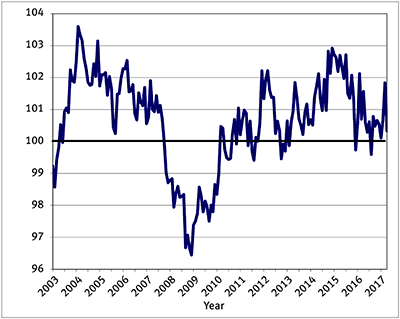In The Cattle Markets
Restaurant Performance Index falls.
The latest data, released June 1, 2017, reflects a steep drop — 1.5% — from March to April in the Restaurant Performance Index (RPI). The RPI is a monthly composite of the health of the U.S. restaurant industry and is measured in values relative to 100. Values exceeding 100 indicate the industry is expanding, while values below 100 indicate contraction.
Values greater than 100 = expansion
Values less than 100 = contraction

Source: National Restaurant Association.
April currently stands at 100.3, just barely over the 100 mark. The National Restaurant Association (NRA) cites a net decline in customer traffic and same-store sales, as well as a decline in optimism over the economy, compared to the March survey. Fig. 1 shows the RPI from 2003 to April 2017.
Using different industry indicators, the RPI can be divided into the current situation or expectations. The current situation part of the index uses four industry indicators: same-store sales, traffic, labor and capital expenditures. This, too, dipped below the previous month, down 2.3% from March to 99.1. The current situation would indicate restaurants are currently in a contraction-oriented phase.
The expectation piece of this index remains expansionary — with the expectation index still over 100, at 101.5 — although it is down 0.7% since March. The expectation index looks at four indicators, as well, but over the next six months. It takes into account restaurant operators’ outlook on same-store sales, employees, capital expenditures and business conditions. Although the index is still over 100, NRA noted April is the lowest expectation index in the last six months.
An expansionary outlook on the economy bodes well for livestock producers and should provide a boost to demand to help lessen the negative effects of the large production numbers that are expected in beef, pork and chicken. However, the decline in the index relative to the first three months of the year in expectations is a bit worrisome and could spell trouble later in the year.
For now though, the outlook remains positive. Another boost to the domestic demand picture is the growing interest in new cuts of meat, which NRA named as the top new food trend in 2017. Vegetarian and vegan dishes were listed as cooling trends. These trendy changes will certainly add to domestic consumption as we see more meat dishes featured throughout the restaurant complex.
Editor’s Note: Katelyn McCullock is an economist for the American Farm Bureau Federation and contributes to the Livestock Marketing Information Center’s “In the Cattle Markets.”






